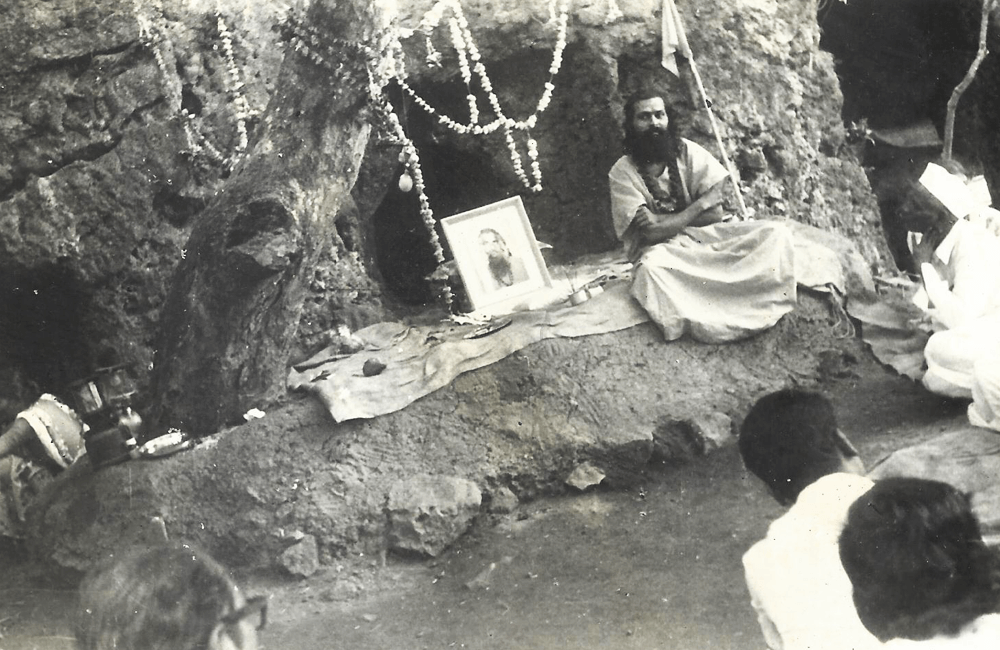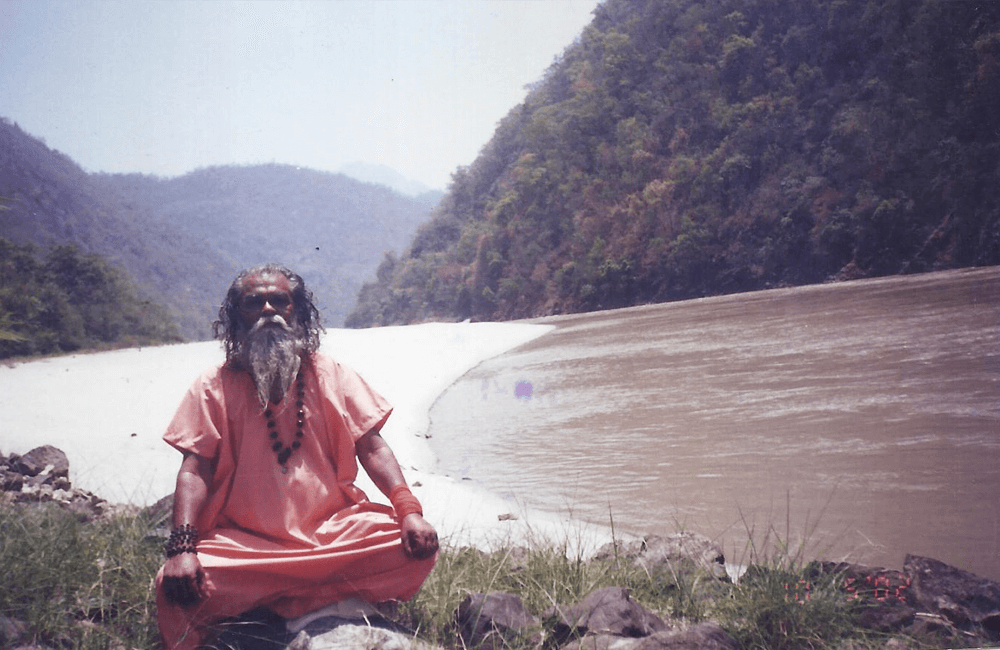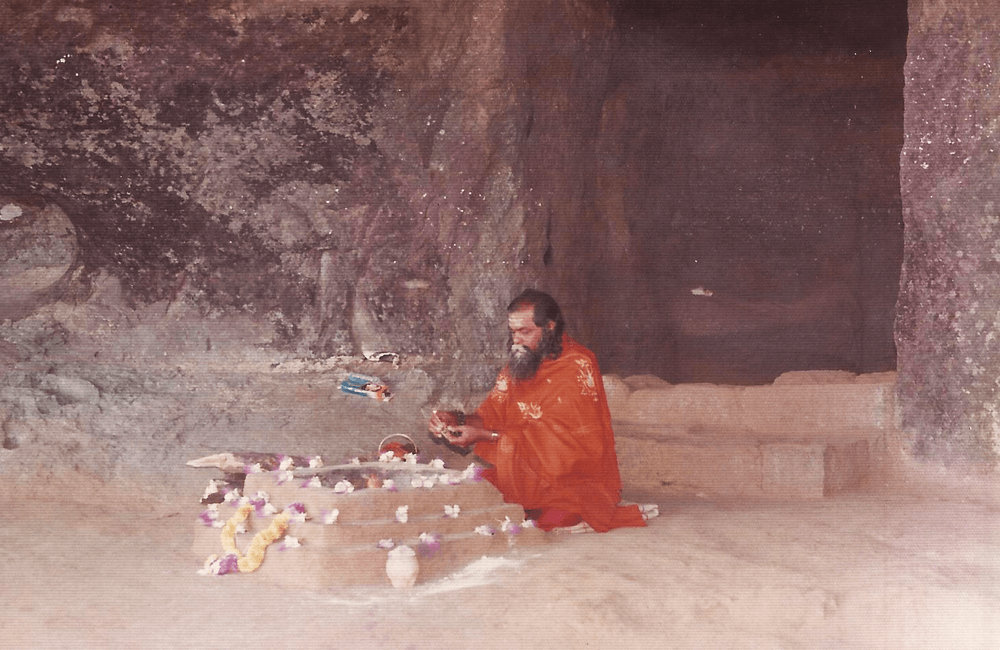Param Pujya Shree Gagananand Maharaj used to do his Sadhana since his early age in the Western Ghats, Himalayas, Nepal (Muktinath), Tibet, Kashmir, Uttarakhand, Walkeshwar, Manori in Malad West Mumbai, Dafalwadi in Mandure – Patan Taluka of Satara District and the Tirthasthal Sohamthan near Nashik.
During the 60’s, he did his Smashaan Sadhana at Banganga, Walkeshwar Crematorium. He followed the principles of Ashtanga Yoga and used the below Yogic techniques as a means to purify the body.
Vasti – Inhaling water through the anus up into the stomach to cleanse the large intestines and other parts of the stomach.
Dhauti – Using a 15 feet long and 1-foot wide fine cloth soaked in water and passing it through the mouth like swallowing it completely. Followed by removing it gently, thereby cleaning the chest alimentary canal and removing cough and other impurities.
Nauli – Massaging and strengthening the abdominal organs by squatting in a sitting position called Padmasana. This is followed by performing a special kind of Pranayama and by the virtue of sheer willpower, Swamiji used to rotate his navel from left to right and vice versa.
Neti – This is a technique, wherein, water is drawn from one nostril and then released through the other nostril and mouth, thereby cleaning the nasal passage.
Kapalghati – A series of Pranayama techniques for purifying the front portion of the brain.
He used the Tratak techniques of concentration, wherein, he would gaze at the Sun continuously for 32 minutes which is believed to bestow special powers and knowledge through the Solar System.
Jal Sadhana in the Ghats of Almora
While returning from a pilgrimage with his Master from Southern India, his Master got into the waters in the Ghats of Almora to do his Jal Sadhana. At this time, Gagananand Maharaj was initiated into performing the Jal Sadhana by his Master.
Shree Gagananand Maharaj throughout his life had done rigorous penance and meditated for days together in complete Samadhi state and achieved all Eight Siddhis namely; Anima, Mahima, Laghima, Garima, Prapti, Prakamya, Vashitwa and Eeshatwa. It is said, that the A Yogi who succeeds in attaining all Eight Siddhis will not seek anything else in his life. A mere wish will get him whatever he wants. Every word he utters proves to be nothing but the truth. He is crowned with the title of Yogiraj – the King of Yogis.
Many devotees have expressed and experienced that Shree Gagananand Maharaj was a fully realised ‘Para Brahman.’ He had become the pinnacle of Spiritual world, as duality ends after a certain stage for Yogis. As the name conferred upon him by his Master suggests, ‘He is a reservoir of bliss as vast as the space’ (GAGANANAND). Even before leaving his body, he indulged in deep Samadhi meditation in a disciplined manner leaving a lot to teach the mankind with regards to perseverance and constant ‘Sattvic’ actions.
Swami Gagananand Maharaj was a ‘Vibhuti’ right in the metropolitan and one did not need to rush to the mountains, caves or solitary jungles in search of a master. He was the one, who personified the below Bhagwat Geeta verses;
श्रीभगवानुवाच | प्रजहाति यदा कामान्सर्वान्पार्थ मनोगतान् |
आत्मन्येवात्मना तुष्ट: स्थितप्रज्ञस्तदोच्यते || 55||
“When a man completely casts off, O partha, All the desires of the mind, and is satisfied in the SELF by the SELF, then he is said to be one with steady wisdom.”
दु:खेष्वनुद्विग्नमना: सुखेषु विगतस्पृह: |
वीतरागभयक्रोध: स्थितधीर्मुनिरुच्यते || 56||
“He whose mind is not shaken by adversity, and who in prosperity does not hanker after pleasure, who is free from attachment, fear and anger, is called a Sage of Steady Wisdom.”
य: सर्वत्रानभिस्नेहस्तत्तत्प्राप्य शुभाशुभम् |
नाभिनन्दति न द्वेष्टि तस्य प्रज्ञा प्रतिष्ठिता || 57||
“He who is everywhere without attachment, on meeting with anything good or bad, who neither rejoices nor hates, his wisdom is fixed. (Sthitha –prajnya) complete equilibrium.”
यदा संहरते चायं कूर्मोऽङ्गानीव सर्वश: |
इन्द्रियाणीन्द्रियार्थेभ्यस्तस्य प्रज्ञा प्रतिष्ठिता || 58||
“When, Like a Tortoise which withdraws its limb from all sides, He withdraws His sense-objects then His wisdom becomes steady.”
All the above qualities can be found in a realised being, herein Yogiraj Swami Gagananad maharaj.”
Maharaj also suggests complete surrender of Mind, Body and intellect with total humility to start your spiritual journey and often quotes
तद्विद्धि प्रणिपातेन परिप्रश्नेन सेवया |
उपदेक्ष्यन्ति ते ज्ञानं ज्ञानिनस्तत्त्वदर्शिन: || 34||
“Know that by long prostration, by question, and service The wise who have realised the Truth will instruct you in that Knowledge.”
According to the different stages of a Jiva, Maharaj stated – that one has to have total faith in the Sadhguru’s words & follow it and he shall eventually be emancipated from this tempestuous sea of illusions. He emphasized a lot on service, charity, devotion to the Lord, chanting of Mantras and Nama Smaran. Also, for the curious, one Jigyasoo Sadhaks, questioning with purity and humility to a certain extent so his answers can emerge from within (Upjat Gyan).
He often told his devotees there is no shortcut or a highway in this journey. Having false expectations and being lured by attractions or imaginations for having read or heard about something, person or an event and believing the same will happen to me, will, in most cases, lead to disappointment. Ours is a ‘Shashwat’ way and a lot of patience and faith has to be exhibited for one to walk on this path.
For the Grihasthashramis, his advice was Nama Smaran – service, charity and performing ones daily obligatory duties with the name of the Lord constantly being recited in their mind. He said, the need of the hour is to turn inward, so people can manage themselves rightfully and also the environment they are living in. One needs to preserve and live in harmony with nature as this has many benefits for the human body, mind and thought process.



